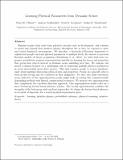| dc.contributor.author | Ullman, Tomer D. | |
| dc.contributor.author | Stuhlmüller, Andreas | |
| dc.contributor.author | Goodman, Noah D. | |
| dc.contributor.author | Tenenbaum, Joshua B. | |
| dc.date.accessioned | 2020-05-01T13:44:01Z | |
| dc.date.available | 2020-05-01T13:44:01Z | |
| dc.date.issued | 2018-04 | |
| dc.date.submitted | 2017-05 | |
| dc.identifier.issn | 0010-0285 | |
| dc.identifier.uri | https://hdl.handle.net/1721.1/124969 | |
| dc.description.abstract | Humans acquire their most basic physical concepts early in development, and continue to enrich and expand their intuitive physics throughout life as they are exposed to more and varied dynamical environments. We introduce a hierarchical Bayesian framework to explain how people can learn physical parameters at multiple levels. In contrast to previous Bayesian models of theory acquisition (Tenenbaum, Kemp, Griffiths, & Goodman, 2011), we work with more expressive probabilistic program representations suitable for learning the forces and properties that govern how objects interact in dynamic scenes unfolding over time. We compare our model to human learners on a challenging task of estimating multiple physical parameters in novel microworlds given short movies. This task requires people to reason simultaneously about multiple interacting physical laws and properties. People are generally able to learn in this setting and are consistent in their judgments. Yet they also make systematic errors indicative of the approximations people might make in solving this computationally demanding problem with limited computational resources. We propose two approximations that complement the top-down Bayesian approach. One approximation model relies on a more bottom-up feature-based inference scheme. The second approximation combines the strengths of the bottom-up and top-down approaches, by taking the feature-based inference as its point of departure for a search in physical-parameter space. Keywords: Learning; Intuitive physics; Probabilistic inference; Physical reasoning; Intuitive theory | en_US |
| dc.description.sponsorship | National Science Foundation (U.S.) (Grant CCF-1231216) | en_US |
| dc.description.sponsorship | National Science Foundation (U.S.) (Grant N00014-13-1-0333) | en_US |
| dc.language.iso | en | |
| dc.publisher | Elsevier BV | en_US |
| dc.relation.isversionof | http://dx.doi.org/10.1016/j.cogpsych.2017.05.006 | en_US |
| dc.rights | Creative Commons Attribution-NonCommercial-NoDerivs License | en_US |
| dc.rights.uri | http://creativecommons.org/licenses/by-nc-nd/4.0/ | en_US |
| dc.source | Other repository | en_US |
| dc.title | Learning physical parameters from dynamic scenes | en_US |
| dc.type | Article | en_US |
| dc.identifier.citation | Ullman, Tomer D. et al. "Learning physical parameters from dynamic scenes." Cognitive Psychology 104 (August 2018): 57-82, © 2017 Elsevier Inc. | en_US |
| dc.contributor.department | Massachusetts Institute of Technology. Department of Brain and Cognitive Sciences | en_US |
| dc.relation.journal | Cognitive Psychology | en_US |
| dc.eprint.version | Original manuscript | en_US |
| dc.type.uri | http://purl.org/eprint/type/JournalArticle | en_US |
| eprint.status | http://purl.org/eprint/status/NonPeerReviewed | en_US |
| dc.date.updated | 2019-10-08T15:01:42Z | |
| dspace.date.submission | 2019-10-08T15:02:00Z | |
| mit.journal.volume | 104 | en_US |
| mit.license | PUBLISHER_CC | |
| mit.metadata.status | Complete | |
